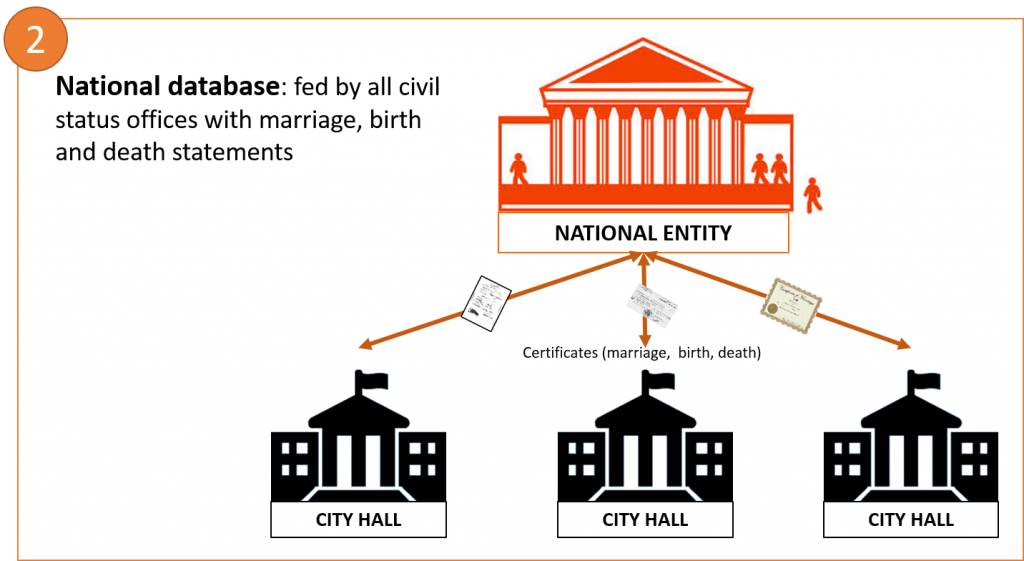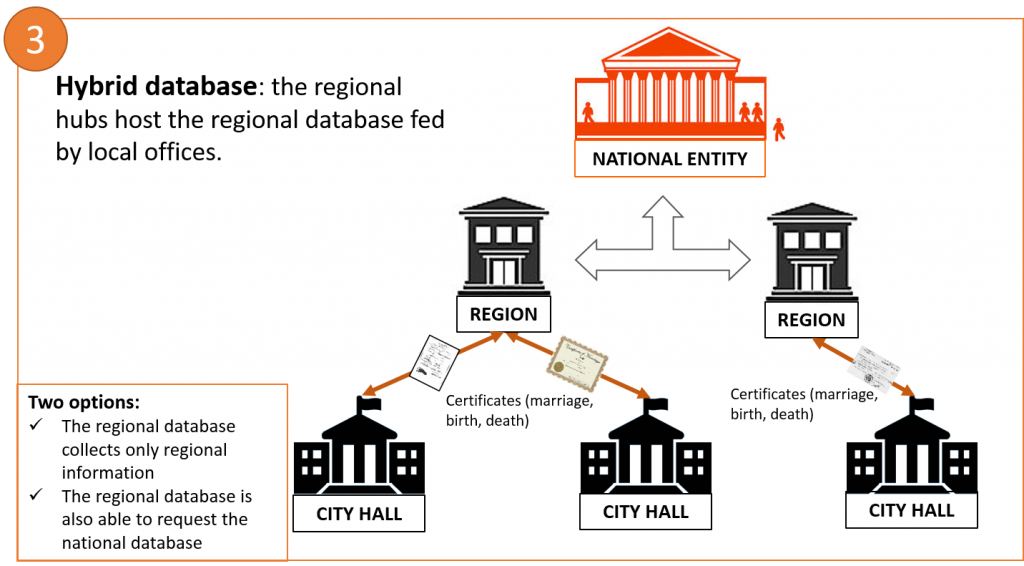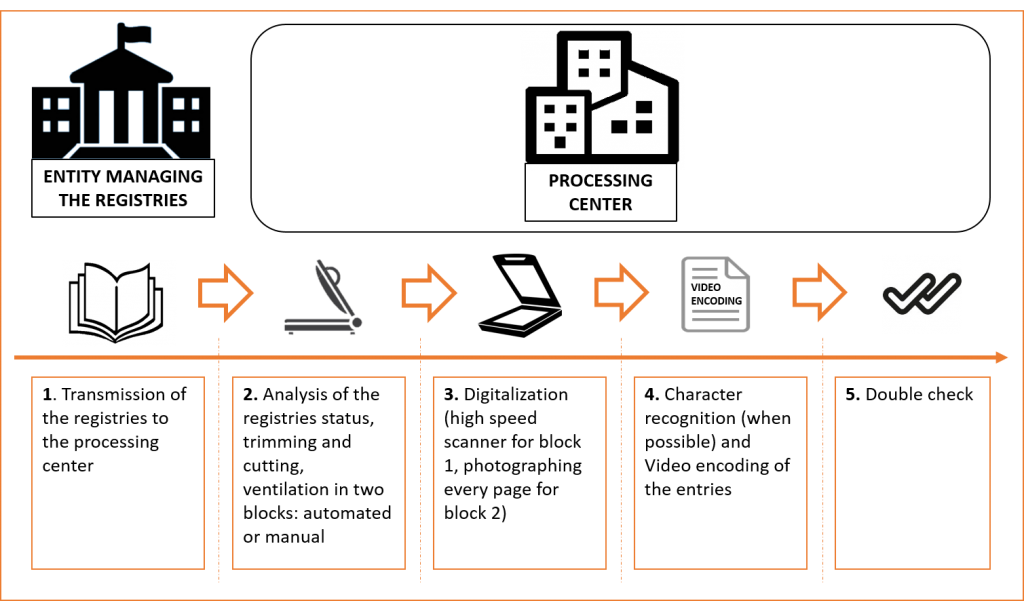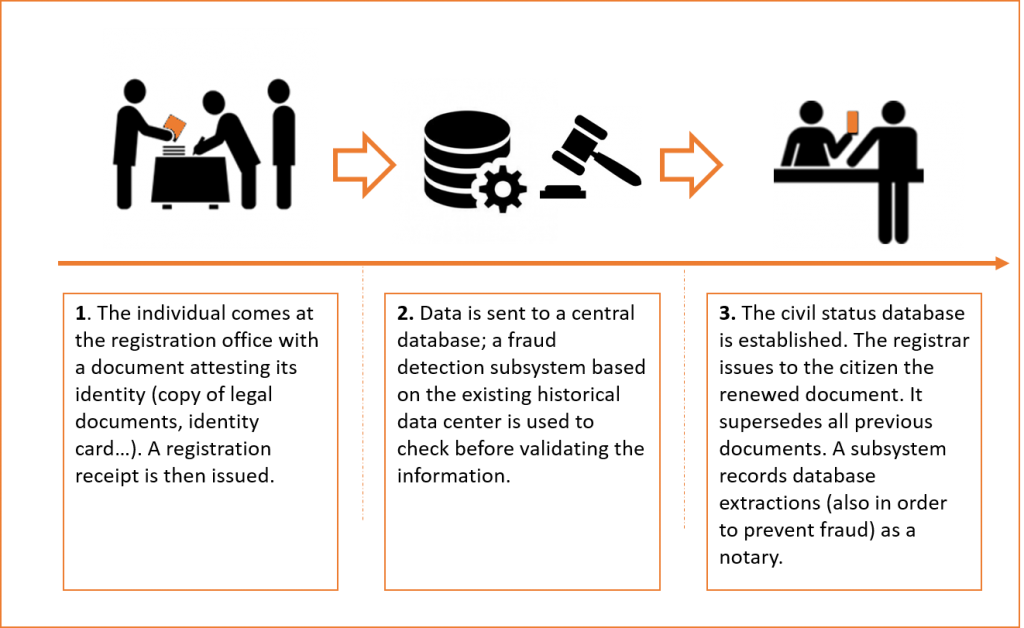EveLiN White paper: Basic facts about Civil registry III
Your country has finally decided to launch a modernization program of its civil registry and you are inquiring about its implementation and the selection of the IT system.
The civil registry management belongs to a sovereign domain; it can only be decided at a National Level to give an identity, to marry two persons, to register a death. Based on this fundamental principle, what you first have to do is to opt for an organization of civil registry procedures being tailored on the sociological reality of the country, which provides the best service to the citizen and takes into account the communication level of the country.
You have to make two key choices:
1 – a choice of human organization
There are two opposing models, on one hand the approach centered on the local official, which is based on the territorial organization of the country and which assigns to him/her the function of CRVS agent, on the other hand the implementation of an organization fully dedicated to the civil status operations which respond to an independent authority.
2 – a selection of a technical architecture
Again, there are two opposing schools: the first one consists in sending to the related birth office all needed documents (marriage, divorce, death); if he/she marries elsewhere, the marriage office has to check at the birth place office the accuracy of the supplied information, that the person is free of any commitments and, once the marriage statement is registered, notify the office where he/she is born to enter the information in its records.
The second method consists in creating a national database which is fed by all civil status offices with marriage, birth and death statements. It is this database that is consulted each time a CRVS agent has to register a statement.
It is, of course, possible to have a mix hybrid system, based on regional hubs which host regional databases fed by local offices.
Schemes below describe these three options:
It is worth mentioning that this type of scheme does not exclude a certain redundancy of the databases. Even in the centralizing scheme in which the local agency is connected to the central site, it is possible to make it autonomous, equipping it with a local database. Once a regional aggregation point is implemented, a regional database is conceivable. These databases can either be fed with their reference population and/or request the central database or even be able to address a regional duplicate base.
The coexistence of all databases is obviously a technical challenge, since we have to ensure the coherence of all these databases. This multiplicity of the databases is an answer to the telecom coverage failure: we have to ensure a minimum service even in case of network coverage breakdown.
The selection of the organization is followed by a “reviewing of the legislation” in order to make it compatible with the computerization project and with the target structure. Traditionally, the civil status legislation is based on paper registries, which must be brought up-to-date.
Reaching the new target structure is a major difficulty of a civil status modernization project. We can consider that a period of 5-7 years can be accepted until the new administrative practice achieves full effectiveness. Throughout this pending phase, the country has to get the support of change management experts.
 The selection of the IT solution supporting the new organization is the easiest part of a modernization project. As in any IT project, it shall go through the elaboration of a Terms of Reference and a call for tender procedure.
The selection of the IT solution supporting the new organization is the easiest part of a modernization project. As in any IT project, it shall go through the elaboration of a Terms of Reference and a call for tender procedure.
Common sense must leads to some main guiding principles:
– Advantage must be to a software package approach on generic functional bases; each country has, of course, its own civil registry particularities, but the functionalities remains the same. The software package is less expensive than a specific development; it must be, however, easy to customize.
– Such an acquisition is commonly evaluated throughout a minimum period of 15 years. The main point is the lifecycle. In order to have a fair comparison, hypothesis on law enhancements and platform updates must be assumed.
– We shall place particular emphasis on the state-of-the-art, well-proven and scalable technologies (thin-client/web, mobile data entry capabilities on smartphones or tablets…).
If we want that the new system reaches its full operational capability in the briefest delay as possible, its databases must be “filled”, from the very beginning, with civil status documents regarding the existing population.
As such, two options are available and must be treated with equal diligence; their operation costs and the reliability of the final result must be assessed.
Traditional approach: scanning of the paper-based registers or integration of the existing databases.
- The sorting of the reliable information which can be resumed without polluting the new database can prove to be prohibitive and inherently arbitrary, as it is undeniable that the measures of information reliability are often subjective.
- The cost of the recovery is also significant: the quality of the paper-based registries is more often than not quite low and their digitalization cannot be automated: a manual and expensive mode must be thus implemented.
- The possible unlikelihood of displacing the registries and of decomposing them in as many unitary sheets as expected leads to an onerous nature of operation. The “industrial” process described below is not always accepted.
New approach: Complete renovation of the civil status, re-registration of the entire population, generating new civil status documents
- Complete census of the population: the operation, generally speaking, shared also other objectives, especially establishing a reliable population registry with no duplication and biometric discriminant.
- The difficulty of this kind of operation is to ensure the reliability of the required information which provides the person’s identity, what are the required documents, how is their authenticity ensured?
A third option is in theory possible consisting in updating the database as new documents are produced. Each new child birth declaration leads to the creation of digital documents related to parents’ birth as well as their marriage (if the union is official). Moreover, every time someone who is not yet included in the database applies for a proof of birth (for a certificate of criminal record for a military file…), his/her information has to be entered in the reference database.
This approach which turns to the re-registration of the entire population over a period of approximately twenty years is a significant challenge in terms of logistics: it is not always easy to adjust the administrative capacity of the organization to meet a demand that could not be easily anticipated; the accuracy of the verification of the “previous” identity data/documents must be maintained over a long period of time which is quite burdensome.
Antoine Boulin: Civil Status Consultant for Digitech company





